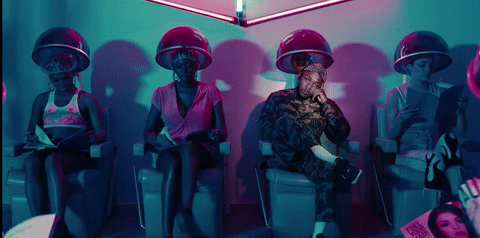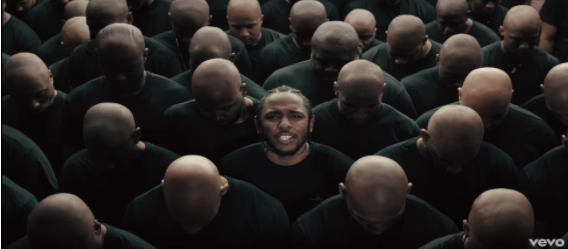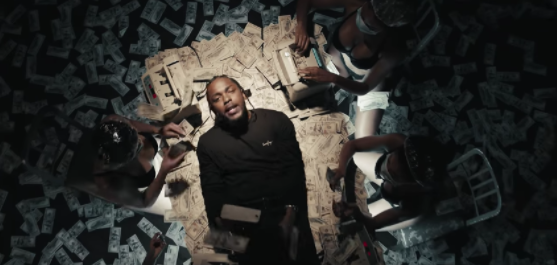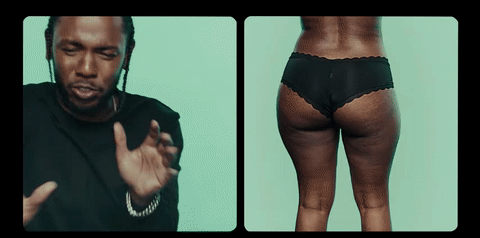Kendrick Lamar // Humble
by Brandi Fullwood on April 5, 2017
Posted in: Hip Hop, Music, Rap, Uncategorized
Kendrick Lamar’s haunting, yet beautiful new music video for Humble warms the part of my heart that can’t stop Instagramming with the a6 filter on #vsco. It’s alarming and exposes a variety of black aesthetics pertaining to violence, endurance, pain, and sex. Directed by Dave Meyers & the Little Homies, the video is seductive and compelling enough to watch back to back. The disregard for black women, however, in the words of Ira Madison III, “keep it.”
Even in the form of rap diss tracks, a black woman’s sex appeal and beauty standards created by men are somehow relevant. When it comes to “woke” rap, people convince themselves that a good beat equals the right message, even when Kendrick Lamar says it. Months of Beyonce’s Lemonade and Solange’s A Seat at the Table prepared me for video aesthetics of black solidarity and sexual liberation, with Kendrick I felt blessed to have another. Then, the mental record scratch happened and I found myself trying to hold onto part of the verse because at least he likes stretch marks, but nah.
After a parade of religious allegories, Kendrick goes on to introduce how he thinks women should humble themselves. At the very least it is a non-sequitor and at most a cry for help in confronting black solidarity that includes women. Call it a casting or creative directing issue if you want, but no line of a song that calls to action natural hair should try and pass off three bundles of wavy hair as “natural.” In just a few lines, the alleged diss track allegedly served to Big Sean became a subtle attack on black women and an assertion of beauty standards shaped by men.

In Humble, Kendrick Lamar urges his rap competition to be more humble in the presence of his lyrical superiority. Yet, themes of black power come forward as cult-like, hierarchical, but also masculine. The message is perhaps meant for Big Sean, J Cole, or anyone that Black Twitter deems Lamar’s viable competition. But, we have a problem, the breakaways that criticize and objectify black women don’t add up to the black solidarity themes present in the music video.
This contradiction, may as well have humbled itself, but let’s unpack this.

The beat bops on a cryptic, heavy, and deep side of the piano. The club ready production by Mike WiLL Made it is the first of many that will be featured on Kendrick’s upcoming album KL4. The sound itself evokes the horrors of racism and gives visual and physicality to violence. Through imagery of hair, religious allegories, and street setting Kendrick puts together yet another narrative grappling with blackness.
Yet, Kendrick has made another complicated piece for black female fans to embrace. The love and compassion for black women in hip hop music video comes with demands. She must be beautiful—bad even—or a grandmama otherwise she is invaluable.
It is not enough to demand or assume power, instead Kendrick dresses and costumes respected authority figures. The music video opens with Kendrick dressed as the pope with a white beanie on. Consumed by a dark room with a single beam of hazy white light, he shouts “Wicked or weakness / You gotta see this.” Intermediately he bow his head and shouts again, “Nobody pray for me/ If you’re not there for me.”
This rap diss track is illuminating, initially it brought together so many interesting ways to signify power and power positioning in rap. However, soon after came an unnecessary flood of curvy dark skinned girls counting money while Kendrick explained his struggles like fond memories.
“Remember syrup sandwiches and crime allowances,” sure, but why do these girls have no clothes on but face masks? Are the working conditions safe or nah? Why is Kendrick getting in the way of them trying to help? Welcome to the symbolism of misogynoir.

Humble is a fascinating contradiction and not the first rap video this year or ever to use black women as props in music videos or sexual objects. Humble introduces its call to action in a sea of bald black men shoulder jerking and popping with Kendrick in agreement. We all need a lesson in humility, so that was cool.
Juxtaposed against a powerful vision of bald solidarity are cut aways to beauty salon shops. Kendrick at times is seen sitting underneath the hair dryer alongside black women. Somebody has to braid his hair too and the short window of appreciation means a lot, but the praise is followed by contradictions—that even Kendrick Lamar might not be well versed in.

We’ve confronted the struggles of wokeness as a black person in America with Kendrick before in To Pimp a Butterfly and acknowledging those struggles won’t stop at KL4. Kendrick Lamar, other “woke” or conscious rap, hip hop and rap in general has a misogyny problem and it’s bigger than a freudian excuse.
Somehow in the scheme of trying to be woke, embracing feminism in hip hop comes with a set of terms that black women have no say in.
I’m so fuckin’ sick and tired of the Photoshop
Show me somethin’ natural like afro on Richard Pryor
As an intention, Humble attempts to understand black women and present as accepting flaws. However, it is not in praise of some black attribute, but a way for Kendrick Lamar to decide whether or not he wants to have sex with a woman.
Show me somethin’ natural like ass with some stretch marks

The consciousness had an idea, but it must of gotten distracted. In the short scene, a model crosses the frame and her glam, but white washed look turns into natural hair and a white tank top (I’m trying to open up the white beater vs wife beater debate). When Kendrick crosses over nothing happens, because he’s ‘real’ and the media can’t change his look. For some reason, the video ignores that masculinity, blackness and beauty standards much more nuanced than that. It also ignores that nobody has to groom themselves for your carnal desires, not even black women.
Still will take you down right on your mama’s couch in Polo socks, ayy
To make matter worse, Kendrick goes ahead and tells the girl he would still sleep with her, but in the mediocre, purposefully disrespectful context of her mama’s living room in some Polo socks he bought from Macy’s. She deserves better and I don’t even know her.
This past summer at Panorama Festival, I watched Kendrick Lamar rap with rage and compassion all to a backdrop of United States micro and macro aggressions. It was the first point of the summer, stained with the slaughter of all kinds of black people, that I cried about blackness and felt cathartic.

Brandi Fullwood for NPR Music
Even after finishing the photos, I lingered on the edge of the crowd to praise Kendrick’s celebration of black solidarity. I’ve gotten used to giving new meanings to misogyny in rap as if it’s integral to the genre, to the culture. I live in nuances everyday and constantly go off to rap because its confidence boosting and I’ve learned to compartmentalizing or ignore references that make props out of women anyway. When the artist boasts “wokeness” and profits off that aesthetic, you know what I am going to critique.
It’s always time for rappers (“woke” or not) and anyone to include black women, even the ones they aren’t related too, even the ones they don’t want to have sex with.



